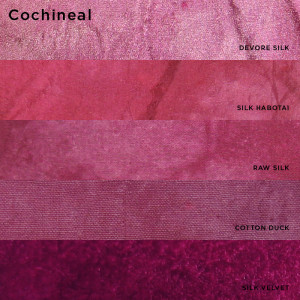 As is often the case, today’s post is brought to you courtesy of Twitter. After the first episode of Wolf Hall aired, there was a raging debate about the colors used in the costumes. I think the main thing that set people off was Henry’s brocade doublet and his bright red schaub coat (how sad is that I only know the German name for that garment, because I’ve spent all my time in that period studying Landsknecht costuming?).
As is often the case, today’s post is brought to you courtesy of Twitter. After the first episode of Wolf Hall aired, there was a raging debate about the colors used in the costumes. I think the main thing that set people off was Henry’s brocade doublet and his bright red schaub coat (how sad is that I only know the German name for that garment, because I’ve spent all my time in that period studying Landsknecht costuming?).
Several people said they were simply too bright, too vivid, etc. to be historically accurate. They landed particularly on the reds as being impossible to achieve in that era (and then purple got brought up, which I’ll tackle next time I post). When I was done scraping my jaw off the floor, the tweets were fast and furious.
 To put it in a nutshell: YOU DO NOT NEED ANILINE DYES TO GET DEEP, BRIGHT, INTENSE COLORS! (and anyone who’s ever looked at extant textiles should know this)
To put it in a nutshell: YOU DO NOT NEED ANILINE DYES TO GET DEEP, BRIGHT, INTENSE COLORS! (and anyone who’s ever looked at extant textiles should know this)
Let’s outline the dye options open to Henry VIII (c. 1525, when he was trying to divorce Catherine):
First and foremost, there was madder root. Madder was cheap and plentiful. It produces decent reds, but is probably not what is being used to produce fancy brocades for the Ki ng of England. Top left you can see Dharma Trading’s madder root swatches, and as you can see, madder is pretty vivid on silk (and would be so on wool).
ng of England. Top left you can see Dharma Trading’s madder root swatches, and as you can see, madder is pretty vivid on silk (and would be so on wool).
The next option is kermes, a red dye made from the body of a Mediterranean insect. It was used throughout Europe and was a highly desirable (and very expensive) dye stuff. If you had money, fabrics made with kermes dyes were readily available. They were widely in use by the Church and by the nobility (and the wealthy in general; we know they were widely  available, because they had sumptuary laws about red in some places). The detail of a 16thC wall hanging to the right is most likely dyed with kermes.
available, because they had sumptuary laws about red in some places). The detail of a 16thC wall hanging to the right is most likely dyed with kermes.
After the Spanish conquest of the Aztecs, you also have Mexican cochineal (first shipment in 1523, so it’s entirely possible that fabrics made with cochineal would have already joined those made with kermes on the open market). Bottom left you have Dharma Trading’s cochineal swatches, which on my compter are trending a little more purplish than they do in real life.
So, while I may have quibbles with the costuming on Wolf Hall (none of Anne’s gowns fit properly which I think is due to the fabric choices being too light for those style gowns; why are some of the men running around in jerkins with no doublets?!), I don’t have any qualms about the color of Henry’s brocade doublet or his overcoat.
For more examples of naturally dyed red clothing, see my post from last year about red Georgian era gowns.

Cool post, Isobel. I’m always kind of amazed at how sure people are of things–sometimes with little or no research to back them up. I am by no means a costume expert, but I always thought they did have bright colors. I assumed many of the examples I’d seen had faded over time and that the brighter ones were items that had seen less wear (and less cleaning) and perhaps been stored away from the light.
There seems to be a persistent myth that natural dyes are muted, muddy, pastel, soft, etc. I do think some of that is from seeing faded extant items, and some is from seeing inexpertly dyed examples from hobbyists.
I ended up having a lovely discussion about dyes with Isabella Whitworth, a textile artist and historian, though. She posts a lot of great stuff on Twitter (@Orchella49).
Great post, Isobel! As you say, these ideas about soft color are persistent, so it helps to put the real case out there as many times as it takes to educate people. I love the swatches you included from Dharma Trading –a good reminder of all the factors that vary, such as the type of material and the length of time left in the dye bath, as well as the source of the dye to start with. I’ll look forward to your post about purple!